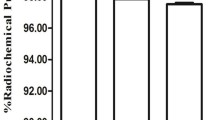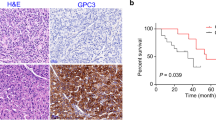Abstract
Purpose
Pancreatic ductal adenocarcinoma (PDAC) is the most lethal gastrointestinal cancer, and its poor prognosis is highly associated with the lack of an efficient early detection technology. Here, we report that RGD-NGR heterodimer labeled with PET isotope could be applied in PDAC early detection.
Procedures
The RGD-NGR tracer was first compared with its corresponding monomeric counterparts via PET imaging studies using mice bearing a subcutaneous BxPC3 tumor. Subsequently, the RGD-NGR tracer was evaluated in autochthonous mouse models with spontaneously developed late stage PanIN lesions (KCER mice) or PDAC (KPC mice) via both PET imaging studies and ex vivo biodistribution studies. Furthermore, a comparison between 2-deoxy-2[18F]fluoro-D-glucose ([18F]F-FDG) and the RGD-NGR tracer was conducted via PET imaging of the same KCH mouse bearing spontaneously developed PDAC. H&E staining was performed to confirm the malignant pancreatic tissue in the KCH mouse. Immunofluorescence staining was performed to confirm the expression of integrin αVβ3 and CD13.
Results
The RGD-NGR tracer exhibited improved in vivo performance as compared with its corresponding monomeric counterparts on the subcutaneous BxPC3 tumor mouse model. Subsequent evaluation in autochthonous mouse models demonstrated its capability to detect both pre-malignant and malignant pancreases. Further comparison with [18F]F-FDG revealed the superiority of the proposed heterodimer in imaging spontaneously developed PDAC. H&E staining confirmed the malignant pancreatic tissue in the KCH mouse, while the expression of both integrin αVβ3 and CD13 receptors was demonstrated with immunofluorescence staining.
Conclusion
The proposed RGD-NGR heterodimer possesses the potential to be applied in the PDAC early detection for high-risk populations.






Similar content being viewed by others
References
Siegel RL, Miller KD, Fuchs HE, Jemal A (2021) Cancer statistics, 2021. CA Cancer J Clin 71:7–33. https://doi.org/10.3322/caac.21654
Amanam I, Chung V (2018) Targeted Therapies for pancreatic cancer. Cancers (Basel) 10:. https://doi.org/10.3390/cancers10020036
Ghadirian P, Lynch HT, Krewski D (2003) Epidemiology of pancreatic cancer: an overview. Cancer Detect Prev 27:87–93. https://doi.org/10.1016/s0361-090x(03)00002-3
Michaud DS (2004) Epidemiology of pancreatic cancer. Minerva Chir 59:99–111
Egawa S, Takeda K, Fukuyama S et al (2004) Clinicopathological aspects of small pancreatic cancer. Pancreas 28:235–240. https://doi.org/10.1097/00006676-200404000-00004
Ariyama J, Suyama M, Satoh K, Sai J (1998) Imaging of small pancreatic ductal adenocarcinoma. Pancreas 16:396–401. https://doi.org/10.1097/00006676-199804000-00030
Neoptolemos JP, Stocken DD, Friess H et al (2004) A randomized trial of chemoradiotherapy and chemotherapy after resection of pancreatic cancer. N Engl J Med 350:1200–1210. https://doi.org/10.1056/NEJMoa032295
Sohn TA, Yeo CJ, Cameron JL et al (2000) Resected adenocarcinoma of the pancreas-616 patients: results, outcomes, and prognostic indicators. J Gastrointest Surg Off J Soc Surg Aliment Tract 4:567–579. https://doi.org/10.1016/s1091-255x(00)80105-5
Saad ED, Machado MC, Wajsbrot D et al (2002) Pretreatment CA 19–9 level as a prognostic factor in patients with advanced pancreatic cancer treated with gemcitabine. Int J Gastrointest Cancer 32:35–41. https://doi.org/10.1385/IJGC:32:1:35
Argani P, Iacobuzio-Donahue C, Ryu B et al (2001) Mesothelin is overexpressed in the vast majority of ductal adenocarcinomas of the pancreas: identification of a new pancreatic cancer marker by serial analysis of gene expression (SAGE). Clin cancer Res an Off J Am Assoc Cancer Res 7:3862–3868
Rocha Lima CMS, Centeno B (2002) Update on pancreatic cancer. Curr Opin Oncol 14:424–430. https://doi.org/10.1097/00001622-200207000-00010
Hingorani SR, Petricoin EF, Maitra A et al (2003) Preinvasive and invasive ductal pancreatic cancer and its early detection in the mouse. Cancer Cell 4:437–450. https://doi.org/10.1016/s1535-6108(03)00309-x
Brand RE, Matamoros A (1998) Imaging techniques in the evaluation of adenocarcinoma of the pancreas. Dig Dis 16:242–252. https://doi.org/10.1159/000016872
Rohren EM, Turkington TG, Coleman RE (2004) Clinical applications of PET in oncology. Radiology 231:305–332. https://doi.org/10.1148/radiol.2312021185
von Schulthess GK, Steinert HC, Hany TF (2006) Integrated PET/CT: current applications and future directions. Radiology 238:405–422. https://doi.org/10.1148/radiol.2382041977
Nakamoto R, Duan H, Ferri V et al (2021) Biodistribution and safety of 18F-FP-R01-MG-F2 knottin PET tracer in patients with pancreatic cancer. J Nucl Med 62:1008
Ray K (2017) Biomarkers for the early detection of PDAC. Nat Rev Gastroenterol Hepatol 14:505. https://doi.org/10.1038/nrgastro.2017.111
Mammen M, Choi S-K, Whitesides GM (1998) Polyvalent Interactions in biological systems: implications for design and use of multivalent ligands and inhibitors. Angew Chem Int Ed Engl 37:2754–2794. https://doi.org/10.1002/(SICI)1521-3773(19981102)37:20%3c2754::AID-ANIE2754%3e3.0.CO;2-3
Zhang J, Mao F, Niu G et al (2018) (68)Ga-BBN-RGD PET/CT for GRPR and integrin α(v)β(3) imaging in patients with breast cancer. Theranostics 8:1121–1130. https://doi.org/10.7150/thno.22601
Desgrosellier JS, Cheresh DA (2010) Integrins in cancer: biological implications and therapeutic opportunities. Nat Rev Cancer 10:9–22. https://doi.org/10.1038/nrc2748
Brooks PC (1996) Role of integrins in angiogenesis. Eur J Cancer 32A:2423–2429. https://doi.org/10.1016/s0959-8049(96)00381-4
Mizejewski GJ (1999) Role of integrins in cancer: survey of expression patterns. Proc Soc Exp Biol Med Soc Exp Biol Med (New York, NY) 222:124–138. https://doi.org/10.1046/j.1525-1373.1999.d01-122.x
Brooks PC, Clark RA, Cheresh DA (1994) Requirement of vascular integrin alpha v beta 3 for angiogenesis. Science 264:569–571. https://doi.org/10.1126/science.7512751
Hosotani R, Kawaguchi M, Masui T et al (2002) Expression of integrin alphaVbeta3 in pancreatic carcinoma: relation to MMP-2 activation and lymph node metastasis. Pancreas 25:e30–e35. https://doi.org/10.1097/00006676-200208000-00021
Kubas H, Schäfer M, Bauder-Wüst U et al (2010) Multivalent cyclic RGD ligands: influence of linker lengths on receptor binding. Nucl Med Biol 37:885–891. https://doi.org/10.1016/j.nucmedbio.2010.06.005
Haubner R, Weber WA, Beer AJ et al (2005) Noninvasive visualization of the activated alphavbeta3 integrin in cancer patients by positron emission tomography and [18F]Galacto-RGD. PLoS Med 2:e70. https://doi.org/10.1371/journal.pmed.0020070
Chen H, Niu G, Wu H, Chen X (2016) Clinical application of radiolabeled RGD peptides for PET imaging of integrin αvβ3. Theranostics 6:78–92. https://doi.org/10.7150/thno.13242
Li Z-B, Cai W, Cao Q et al (2007) (64)Cu-labeled tetrameric and octameric RGD peptides for small-animal PET of tumor alpha(v)beta(3) integrin expression. J Nucl Med 48:1162–1171. https://doi.org/10.2967/jnumed.107.039859
Yoshimoto M, Hayakawa T, Mutoh M et al (2012) In vivo SPECT imaging with 111In-DOTA-c(RGDfK) to detect early pancreatic cancer in a hamster pancreatic carcinogenesis model. J Nucl Med 53:765–771. https://doi.org/10.2967/jnumed.111.099630
Trajkovic-Arsic M, Mohajerani P, Sarantopoulos A et al (2014) Multimodal molecular imaging of integrin αvβ3 for in vivo detection of pancreatic cancer. J Nucl Med 55:446–451. https://doi.org/10.2967/jnumed.113.129619
Ikeda N, Nakajima Y, Tokuhara T et al (2003) Clinical significance of aminopeptidase N/CD13 expression in human pancreatic carcinoma. Clin cancer Res an Off J Am Assoc Cancer Res 9:1503–1508
van Hensbergen Y, Broxterman HJ, Rana S et al (2004) Reduced growth, increased vascular area, and reduced response to cisplatin in CD13-overexpressing human ovarian cancer xenografts. Clin Cancer Res 10:1180–1191. https://doi.org/10.1158/1078-0432.CCR-0482-3
Surowiak P, Drag M, Materna V et al (2006) Expression of aminopeptidase N/CD13 in human ovarian cancers. Int J Gynecol cancer Off J Int Gynecol Cancer Soc 16:1783–1788. https://doi.org/10.1111/j.1525-1438.2006.00657.x
Zhang Q, Wang J, Zhang H et al (2015) Expression and clinical significance of aminopeptidase N/CD13 in non-small cell lung cancer. J Cancer Res Ther 11:223–228. https://doi.org/10.4103/0973-1482.138007
Tokuhara T, Hattori N, Ishida H et al (2006) Clinical significance of aminopeptidase N in non–small cell lung cancer. Clin Cancer Res 12:3971–3978. https://doi.org/10.1158/1078-0432.CCR-06-0338
Hashida H, Takabayashi A, Kanai M et al (2002) Aminopeptidase N is involved in cell motility and angiogenesis: its clinical significance in human colon cancer. Gastroenterology 122:376–386. https://doi.org/10.1053/gast.2002.31095
Curnis F, Arrigoni G, Sacchi A et al (2002) Differential binding of drugs containing the NGR motif to CD13 isoforms in tumor vessels, epithelia, and myeloid cells. Cancer Res 62:867–874
Faintuch BL, Oliveira EA, Targino RC, Moro AM (2014) Radiolabeled NGR phage display peptide sequence for tumor targeting. Appl Radiat Isot 86:41–45. https://doi.org/10.1016/j.apradiso.2013.12.035
Gai Y, Jiang Y, Long Y et al (2020) Evaluation of an integrin αvβ3 and aminopeptidase N dual-receptor targeting tracer for breast cancer imaging. Mol Pharm 17:349–358. https://doi.org/10.1021/acs.molpharmaceut.9b01134
Kopinke D, Brailsford M, Pan FC et al (2012) Ongoing Notch signaling maintains phenotypic fidelity in the adult exocrine pancreas. Dev Biol 362:57–64. https://doi.org/10.1016/j.ydbio.2011.11.010
Hingorani SR, Wang L, Multani AS et al (2005) Trp53R172H and KrasG12D cooperate to promote chromosomal instability and widely metastatic pancreatic ductal adenocarcinoma in mice. Cancer Cell 7:469–483. https://doi.org/10.1016/j.ccr.2005.04.023
Kang R, Xie Y, Zhang Q et al (2017) Intracellular HMGB1 as a novel tumor suppressor of pancreatic cancer. Cell Res 27:916–932. https://doi.org/10.1038/cr.2017.51
Herreros-Villanueva M, Hijona E, Cosme A, Bujanda L (2012) Mouse models of pancreatic cancer. World J Gastroenterol 18:1286–1294. https://doi.org/10.3748/wjg.v18.i12.1286
Martin SP, Ulrich CD 2nd (2000) Pancreatic cancer surveillance in a high-risk cohort Is it worth the cost? Med Clin North Am 84:739–47. https://doi.org/10.1016/s0025-7125(05)70255-8 (xii–xiii)
Acknowledgements
We thank Ms. Kathryn Elizabeth Day and Mr. William Packwood for their assistance in the PET imaging studies.
Funding
This work was supported by the National Institute of Biomedical Imaging and Bioengineering grant (R21-EB020737) and the American Cancer Society Research Scholar (no. ACS-RSG-17–004-01-CCE). Preclinical PET/CT imaging was supported in part by P30CA047904 (UPCI CCSG).
Author information
Authors and Affiliations
Corresponding authors
Ethics declarations
Conflict of Interest
The authors declare that they have no conflict of interests.
Additional information
Publisher's Note
Springer Nature remains neutral with regard to jurisdictional claims in published maps and institutional affiliations.
Supplementary Information
Below is the link to the electronic supplementary material.
Rights and permissions
About this article
Cite this article
Sun, L., Gai, Y., Li, Z. et al. Heterodimeric RGD-NGR PET Tracer for the Early Detection of Pancreatic Cancer. Mol Imaging Biol 24, 580–589 (2022). https://doi.org/10.1007/s11307-022-01704-6
Received:
Revised:
Accepted:
Published:
Issue Date:
DOI: https://doi.org/10.1007/s11307-022-01704-6




